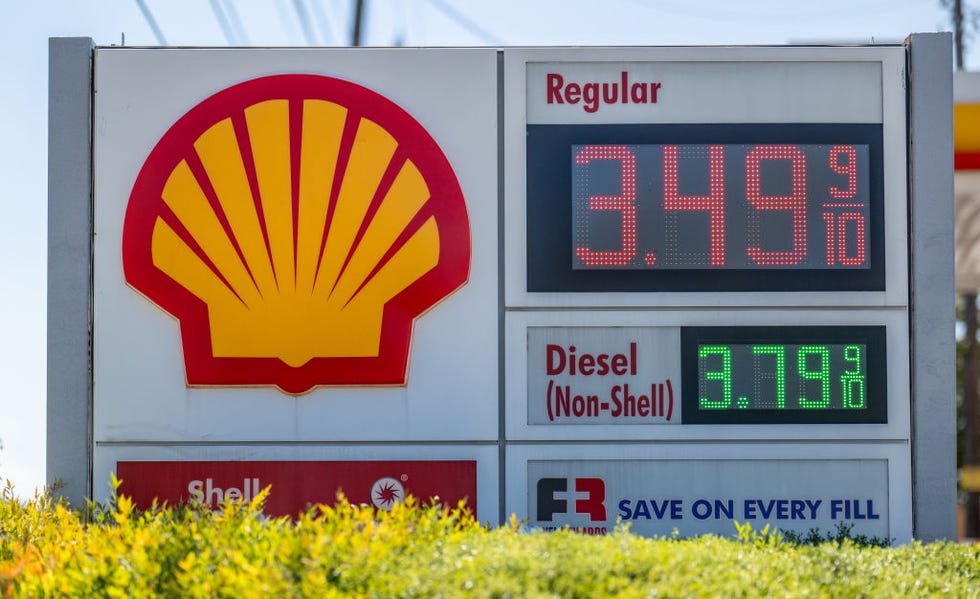High Gas Prices Helped Along by High Heat Records
High Gas Prices Helped Along by High Heat Records Car and Driver


Heat-Related Refinery Outages Impact Gas Prices in the U.S.
- Heat-related refinery outages helped shut down some petroleum refining capacity in the U.S. last month, and drivers are noticing the changes at the pump.
- The national average gas price for a gallon of gas shot up to $3.82 this week, the highest since October 2022.
- Other factors contributing to your paying more to fill up are rising prices for a barrel of oil and lower gasoline inventory supplies. And if more hurricanes arrive soon, they may cause prices to climb again.
If you’re still pumping your car full of liquid energy, you’ve probably noticed a higher price recently. You’re not alone. Gas prices have reached a nine-month high nationwide, thanks to both familiar and unexpected causes.
During the last week of July, the average price of a gallon of gasoline shot up 16.5 cents, to $3.72 a gallon, according to GasBuddy. Diesel fuel also shot up 15.5 cents to an average of $3.99 per gallon. On August 3, GasBuddy saw the national average rise to $3.82 a gallon, the highest since October 2022.
Factors Contributing to Price Spikes
Those price spikes were due to three main factors, GasBuddy’s head of petroleum analysis, Patrick De Haan, said in a statement: heat-related refinery outages, strong summer demand for gasoline, and gasoline inventories that were at their lowest July level since 2015.
Strong demand and low inventories are classic high-gas-price triggers, but heat-related outages are less common. AAA, which tracks gas prices, said the extreme heat we’re all experiencing this summer meant some U.S. refineries, especially those near the Gulf of Mexico, had to cut back. Due to the high heat, the U.S. refined around 500,000 fewer barrels a day than usual.
Hottest Month Ever
July was the hottest month in all of recorded human history. The transportation sector, including personal cars and trucks as well as commercial vehicles, airplanes, and trains, is one of the most significant contributors to anthropogenic U.S. greenhouse gas (GHG) emissions, which contribute to climate change. Transportation accounted for almost a third (29 percent) of all U.S. GHG emissions in 2021.
The heat wave is only partly responsible for the high gas prices, however. The cost of a barrel of oil started climbing in July from the high-$60s to mid-$70s that we saw in May and June to more than $80. AAA said the recent increase was due to the end of releases from the strategic petroleum reserve and “concerns over cuts in supply from Saudi Arabia and Russia, the second- and third-largest oil producers in the world
SDGs, Targets, and Indicators
1. SDGs Addressed
- SDG 7: Affordable and Clean Energy
- SDG 9: Industry, Innovation, and Infrastructure
- SDG 11: Sustainable Cities and Communities
- SDG 13: Climate Action
2. Targets Identified
- SDG 7.2: Increase substantially the share of renewable energy in the global energy mix
- SDG 9.4: Upgrade infrastructure and retrofit industries to make them sustainable
- SDG 11.6: Reduce the adverse per capita environmental impact of cities
- SDG 13.1: Strengthen resilience and adaptive capacity to climate-related hazards
3. Indicators Mentioned
- Heat-related refinery outages
- Gasoline inventories at their lowest July level since 2015
- Rising prices for a barrel of oil
- Gasoline inventories down 2.8 percent from a year ago
- Gasoline inventories 6 percent below the five-year average for this time of year
Table: SDGs, Targets, and Indicators
| SDGs | Targets | Indicators |
|---|---|---|
| SDG 7: Affordable and Clean Energy | SDG 7.2: Increase substantially the share of renewable energy in the global energy mix | Heat-related refinery outages |
| SDG 9: Industry, Innovation, and Infrastructure | SDG 9.4: Upgrade infrastructure and retrofit industries to make them sustainable | Rising prices for a barrel of oil |
| SDG 11: Sustainable Cities and Communities | SDG 11.6: Reduce the adverse per capita environmental impact of cities | Gasoline inventories at their lowest July level since 2015 |
| SDG 13: Climate Action | SDG 13.1: Strengthen resilience and adaptive capacity to climate-related hazards | Gasoline inventories down 2.8 percent from a year ago Gasoline inventories 6 percent below the five-year average for this time of year |
Analysis:
1. The issues highlighted in the article are connected to multiple SDGs. These include:
– SDG 7: Affordable and Clean Energy, as the article discusses the impact of heat-related refinery outages on petroleum refining capacity and gas prices.
– SDG 9: Industry, Innovation, and Infrastructure, as the article mentions rising prices for a barrel of oil, which affects the industry and infrastructure.
– SDG 11: Sustainable Cities and Communities, as the article refers to gasoline inventories at their lowest July level since 2015, which relates to urban sustainability.
– SDG 13: Climate Action, as the article mentions the heat wave and its contribution to greenhouse gas emissions from the transportation sector.
2. Based on the article’s content, specific targets under the identified SDGs can be identified:
– SDG 7.2: Increase substantially the share of renewable energy in the global energy mix, as the article highlights the impact of heat-related refinery outages on petroleum refining capacity, which can be mitigated by transitioning to renewable energy sources.
– SDG 9.4: Upgrade infrastructure and retrofit industries to make them sustainable, as the article discusses rising prices for a barrel of oil, indicating the need for sustainable infrastructure and industry practices.
– SDG 11.6: Reduce the adverse per capita environmental impact of cities, as the article mentions gasoline inventories at their lowest July level since 2015, indicating the need for sustainable urban transportation and energy systems.
– SDG 13.1: Strengthen resilience and adaptive capacity to climate-related hazards, as the article highlights the impact of heat-related refinery outages and low gasoline inventories, which are influenced by climate-related factors.
3. The article mentions several indicators that can be used to measure progress towards the identified targets:
– Heat-related refinery outages: This indicator reflects the vulnerability of petroleum refining capacity to extreme weather events and can be used to assess progress in transitioning to more resilient and sustainable energy systems (SDG 7.2).
– Gasoline inventories at their lowest July level since 2015: This indicator indicates the need for improved inventory management and supply chain resilience in the petroleum industry, contributing to sustainable infrastructure and industry practices (SDG 9.4).
– Rising prices for a barrel of oil: This indicator reflects market dynamics and can be used to assess progress in reducing dependence on fossil fuels and promoting renewable energy sources (SDG 9.4).
– Gasoline inventories down 2.8 percent from a year ago and 6 percent below the five-year average for this time of year: These indicators highlight the need for improved inventory management and supply chain resilience in the petroleum industry, contributing to sustainable infrastructure and industry practices (SDG 9.4) and climate resilience (SDG 13.1).
Overall, the article highlights the interconnectedness of various SDGs and the need for sustainable solutions to address the challenges in the petroleum industry and transportation sector. By considering the identified targets and indicators, policymakers and stakeholders can track progress and take appropriate actions to achieve sustainable development goals.
Behold! This splendid article springs forth from the wellspring of knowledge, shaped by a wondrous proprietary AI technology that delved into a vast ocean of data, illuminating the path towards the Sustainable Development Goals. Remember that all rights are reserved by SDG Investors LLC, empowering us to champion progress together.
Source: caranddriver.com

Join us, as fellow seekers of change, on a transformative journey at https://sdgtalks.ai/welcome, where you can become a member and actively contribute to shaping a brighter future.








